2021 NISSAN ROGUE SPORT maintenance
[x] Cancel search: maintenancePage 476 of 516

9-20Maintenance and schedules
105,000 Miles/84 Months/168,000
Km
Standard maintenance:.Inspect brake lines and cables.Inspect brake pads and rotors.Inspect engine drive belts.Inspect propeller shaft (AWD models).Inspect differential gear oil.Inspect transfer case oil (AWD models).Inspect drive shaft boots (AWD models).Inspect CVT fluid.Inspect manual transaxle gear oil.Replace engine coolant (1).Replace engine oil and filter.Replace in-cabin microfilter.Replace spark plugs (2).Perform tire rotation
Severe maintenance:
Not Applicable. Proceed to next interval.
(1) First replacement interval is 105,000 miles
(168,000 km) or 84 months. After first repla-
cement, replace every 75,000 miles (120,000
km) or 60 months.
(2) Replace spark plug when the plug gap
exceeds 0.053 in (1.35 mm) even if within
specified replacement mileage.
105,000 Miles/126 Months/168,000
Km
Standard maintenance:
Not Applicable. Proceed to next interval.
Severe maintenance:
.Inspect brake pads and rotors.Inspect steering gear and linkage.Inspect axle and suspension parts.Inspect propeller shaft (AWD models).Inspect drive shaft boots (AWD models).Inspect exhaust system.Replace engine oil and filter
110,000 Miles/132 Months/176,000
Km
Standard maintenance:
Not Applicable. Proceed to next interval.
Severe maintenance:
.Inspect brake pads and rotors.Inspect steering gear and linkage.Inspect axle and suspension parts.Inspect propeller shaft (AWD models).Inspect drive shaft boots (AWD models).Inspect exhaust system.Replace engine oil and filter.Replace brake fluid
Page 477 of 516
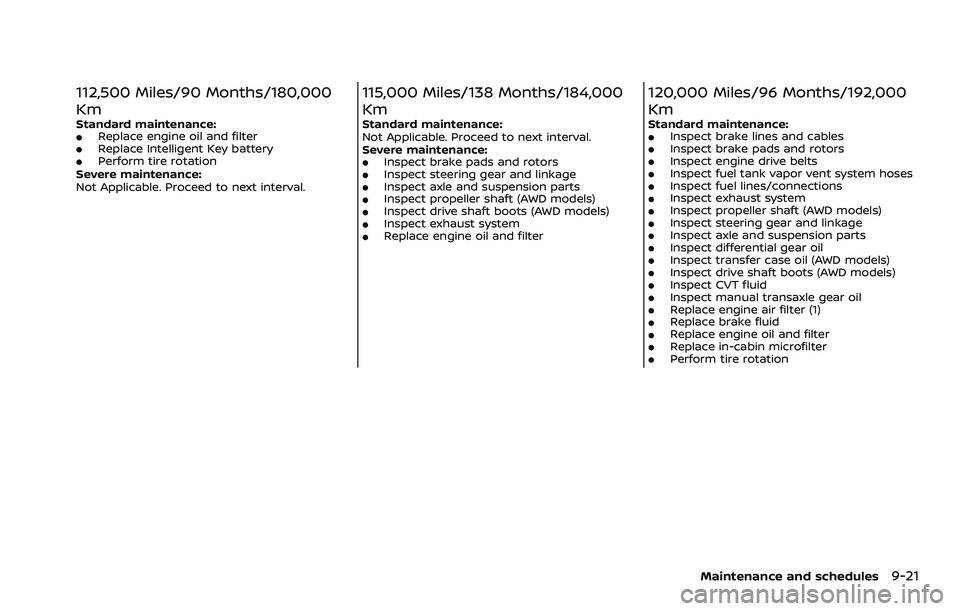
112,500 Miles/90 Months/180,000
Km
Standard maintenance:.Replace engine oil and filter.Replace Intelligent Key battery.Perform tire rotation
Severe maintenance:
Not Applicable. Proceed to next interval.
115,000 Miles/138 Months/184,000
Km
Standard maintenance:
Not Applicable. Proceed to next interval.
Severe maintenance:
.Inspect brake pads and rotors.Inspect steering gear and linkage.Inspect axle and suspension parts.Inspect propeller shaft (AWD models).Inspect drive shaft boots (AWD models).Inspect exhaust system.Replace engine oil and filter
120,000 Miles/96 Months/192,000
Km
Standard maintenance:.Inspect brake lines and cables.Inspect brake pads and rotors.Inspect engine drive belts.Inspect fuel tank vapor vent system hoses.Inspect fuel lines/connections.Inspect exhaust system.Inspect propeller shaft (AWD models).Inspect steering gear and linkage.Inspect axle and suspension parts.Inspect differential gear oil.Inspect transfer case oil (AWD models).Inspect drive shaft boots (AWD models).Inspect CVT fluid.Inspect manual transaxle gear oil.Replace engine air filter (1).Replace brake fluid.Replace engine oil and filter.Replace in-cabin microfilter.Perform tire rotation
Maintenance and schedules9-21
Page 478 of 516
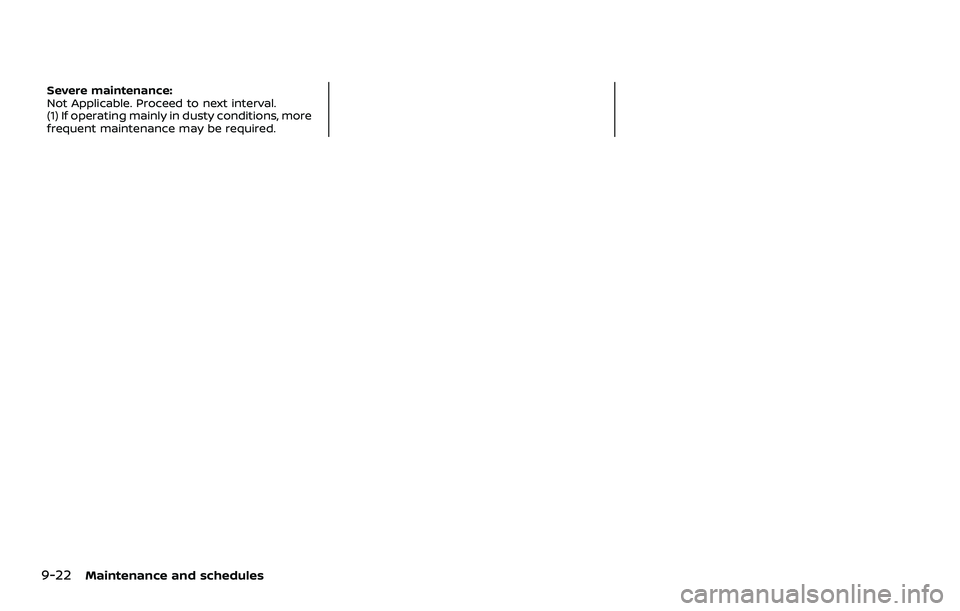
9-22Maintenance and schedules
Severe maintenance:
Not Applicable. Proceed to next interval.
(1) If operating mainly in dusty conditions, more
frequent maintenance may be required.
Page 479 of 516

10 Technical and consumer information
Capacities and
recommended fluids/lubricants .................................... 10-2Fuel information .................................................................. 10-3
Engine oil and oil filter recommendation ........ 10-5
Air conditioning system refrigerant and
oil recommendations ....................................................... 10-6
Specifications ........................................................................\
........ 10-7 Engine ........................................................................\
.................. 10-7
Wheels and tires .................................................................. 10-7
Dimensions and weights .............................................. 10-8
When traveling or registering in
another country ........................................................................\
. 10-8
Vehicle identification .............................................................. 10-8 Vehicle Identification Number (VIN) plate ....... 10-8
Vehicle identification number
(chassis number) ................................................................. 10-9
Engine serial number ....................................................... 10-9
F.M.V.S.S./C.M.V.S.S. certification label ................. 10-9
Emission control information label .................. 10-10
Tire and Loading Information label ................. 10-10
Air conditioner specification label ..................... 10-10
Installing front license plate ......................................... 10-12
Vehicle loading information .......................................... 10-12
Terms ........................................................................\
................ 10-12 Vehicle load capacity ................................................ 10-13
Securing the load ......................................................... 10-14
Loading tips ...................................................................... 10-14
Measurement of weights ....................................... 10-15
Towing a trailer ...................................................................... 10-15
Flat towing ........................................................................\
......... 10-16
Flat towing for All–Wheel Drive vehicle
(if so equipped) ............................................................... 10-16
Flat towing for Front-Wheel Drive vehicle
(if so equipped) ............................................................... 10-16
Uniform tire quality grading ........................................ 10-17 Treadwear ........................................................................\
.. 10-17
Traction AA, A, B and C ........................................... 10-17
Temperature A, B and C ......................................... 10-17
Emission control system warranty ......................... 10-18
Reporting safety defects ................................................ 10-18
Readiness for Inspection/Maintenance
(I/M) test ........................................................................\
............... 10-19
Event Data Recorders (EDR) ......................................... 10-20 Additional data recording (on vehicles
equipped with optional
ProPILOT assist) ............................................................. 10-20
Owner’s manual/service manual
order information ................................................................. 10-21
Page 483 of 516
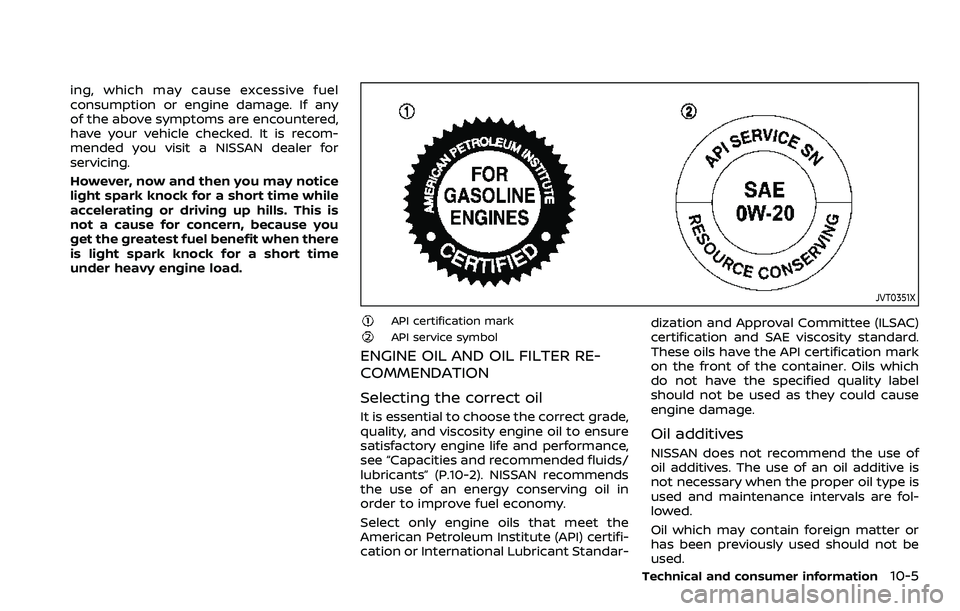
ing, which may cause excessive fuel
consumption or engine damage. If any
of the above symptoms are encountered,
have your vehicle checked. It is recom-
mended you visit a NISSAN dealer for
servicing.
However, now and then you may notice
light spark knock for a short time while
accelerating or driving up hills. This is
not a cause for concern, because you
get the greatest fuel benefit when there
is light spark knock for a short time
under heavy engine load.
JVT0351X
API certification markAPI service symbol
ENGINE OIL AND OIL FILTER RE-
COMMENDATION
Selecting the correct oil
It is essential to choose the correct grade,
quality, and viscosity engine oil to ensure
satisfactory engine life and performance,
see “Capacities and recommended fluids/
lubricants” (P.10-2). NISSAN recommends
the use of an energy conserving oil in
order to improve fuel economy.
Select only engine oils that meet the
American Petroleum Institute (API) certifi-
cation or International Lubricant Standar-dization and Approval Committee (ILSAC)
certification and SAE viscosity standard.
These oils have the API certification mark
on the front of the container. Oils which
do not have the specified quality label
should not be used as they could cause
engine damage.
Oil additives
NISSAN does not recommend the use of
oil additives. The use of an oil additive is
not necessary when the proper oil type is
used and maintenance intervals are fol-
lowed.
Oil which may contain foreign matter or
has been previously used should not be
used.
Technical and consumer information10-5
Page 484 of 516
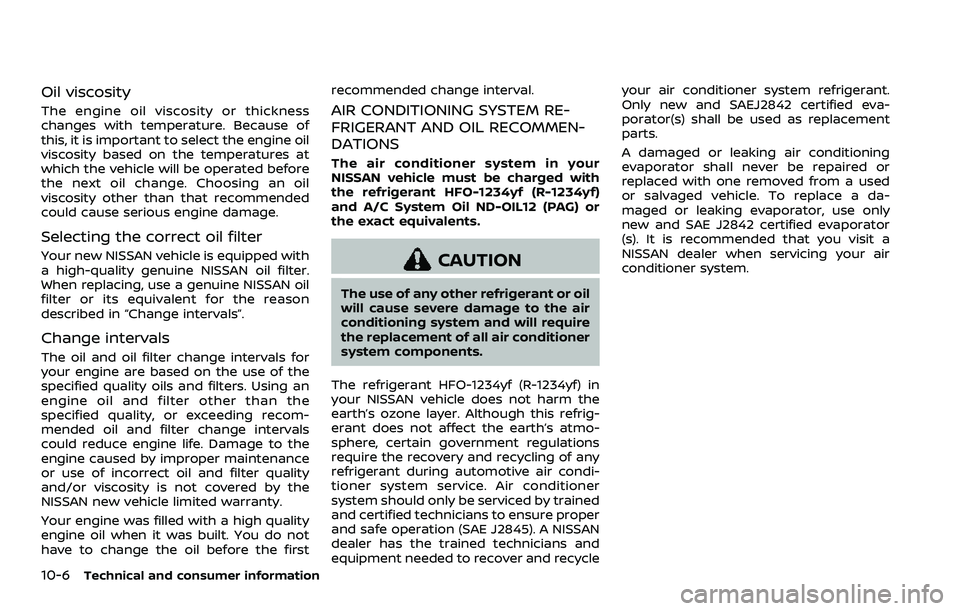
10-6Technical and consumer information
Oil viscosity
The engine oil viscosity or thickness
changes with temperature. Because of
this, it is important to select the engine oil
viscosity based on the temperatures at
which the vehicle will be operated before
the next oil change. Choosing an oil
viscosity other than that recommended
could cause serious engine damage.
Selecting the correct oil filter
Your new NISSAN vehicle is equipped with
a high-quality genuine NISSAN oil filter.
When replacing, use a genuine NISSAN oil
filter or its equivalent for the reason
described in “Change intervals”.
Change intervals
The oil and oil filter change intervals for
your engine are based on the use of the
specified quality oils and filters. Using an
engine oil and filter other than the
specified quality, or exceeding recom-
mended oil and filter change intervals
could reduce engine life. Damage to the
engine caused by improper maintenance
or use of incorrect oil and filter quality
and/or viscosity is not covered by the
NISSAN new vehicle limited warranty.
Your engine was filled with a high quality
engine oil when it was built. You do not
have to change the oil before the firstrecommended change interval.
AIR CONDITIONING SYSTEM RE-
FRIGERANT AND OIL RECOMMEN-
DATIONS
The air conditioner system in your
NISSAN vehicle must be charged with
the refrigerant HFO-1234yf (R-1234yf)
and A/C System Oil ND-OIL12 (PAG) or
the exact equivalents.
CAUTION
The use of any other refrigerant or oil
will cause severe damage to the air
conditioning system and will require
the replacement of all air conditioner
system components.
The refrigerant HFO-1234yf (R-1234yf) in
your NISSAN vehicle does not harm the
earth’s ozone layer. Although this refrig-
erant does not affect the earth’s atmo-
sphere, certain government regulations
require the recovery and recycling of any
refrigerant during automotive air condi-
tioner system service. Air conditioner
system should only be serviced by trained
and certified technicians to ensure proper
and safe operation (SAE J2845). A NISSAN
dealer has the trained technicians and
equipment needed to recover and recycle your air conditioner system refrigerant.
Only new and SAEJ2842 certified eva-
porator(s) shall be used as replacement
parts.
A damaged or leaking air conditioning
evaporator shall never be repaired or
replaced with one removed from a used
or salvaged vehicle. To replace a da-
maged or leaking evaporator, use only
new and SAE J2842 certified evaporator
(s). It is recommended that you visit a
NISSAN dealer when servicing your air
conditioner system.
Page 497 of 516
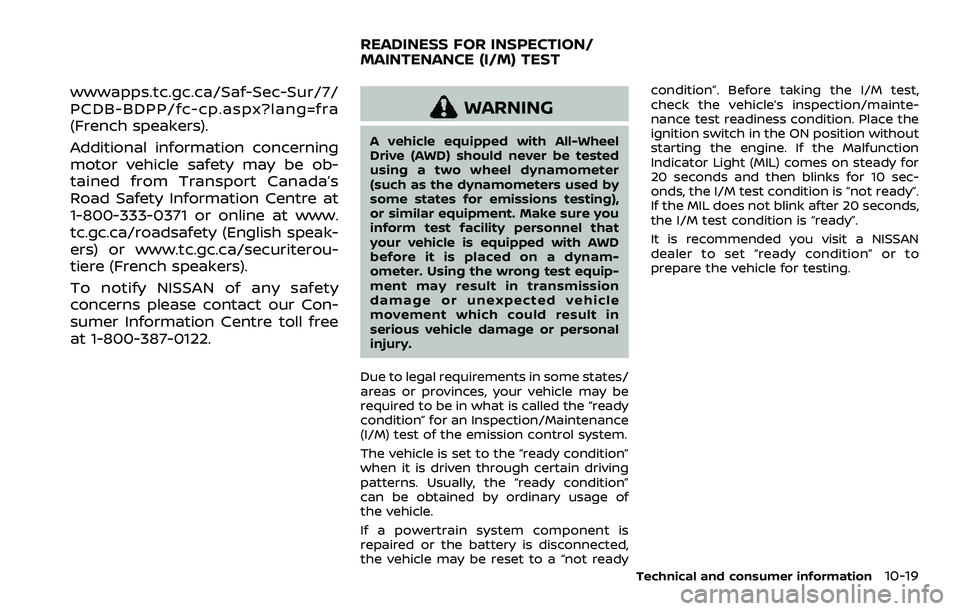
wwwapps.tc.gc.ca/Saf-Sec-Sur/7/
PCDB-BDPP/fc-cp.aspx?lang=fra
(French speakers).
Additional information concerning
motor vehicle safety may be ob-
tained from Transport Canada’s
Road Safety Information Centre at
1-800-333-0371 or online at www.
tc.gc.ca/roadsafety (English speak-
ers) or www.tc.gc.ca/securiterou-
tiere (French speakers).
To notify NISSAN of any safety
concerns please contact our Con-
sumer Information Centre toll free
at 1-800-387-0122.
WARNING
A vehicle equipped with All-Wheel
Drive (AWD) should never be tested
using a two wheel dynamometer
(such as the dynamometers used by
some states for emissions testing),
or similar equipment. Make sure you
inform test facility personnel that
your vehicle is equipped with AWD
before it is placed on a dynam-
ometer. Using the wrong test equip-
ment may result in transmission
damage or unexpected vehicle
movement which could result in
serious vehicle damage or personal
injury.
Due to legal requirements in some states/
areas or provinces, your vehicle may be
required to be in what is called the “ready
condition” for an Inspection/Maintenance
(I/M) test of the emission control system.
The vehicle is set to the “ready condition”
when it is driven through certain driving
patterns. Usually, the “ready condition”
can be obtained by ordinary usage of
the vehicle.
If a powertrain system component is
repaired or the battery is disconnected,
the vehicle may be reset to a “not ready condition”. Before taking the I/M test,
check the vehicle’s inspection/mainte-
nance test readiness condition. Place the
ignition switch in the ON position without
starting the engine. If the Malfunction
Indicator Light (MIL) comes on steady for
20 seconds and then blinks for 10 sec-
onds, the I/M test condition is “not ready”.
If the MIL does not blink after 20 seconds,
the I/M test condition is “ready”.
It is recommended you visit a NISSAN
dealer to set “ready condition” or to
prepare the vehicle for testing.
Technical and consumer information10-19
READINESS FOR INSPECTION/
MAINTENANCE (I/M) TEST
Page 504 of 516
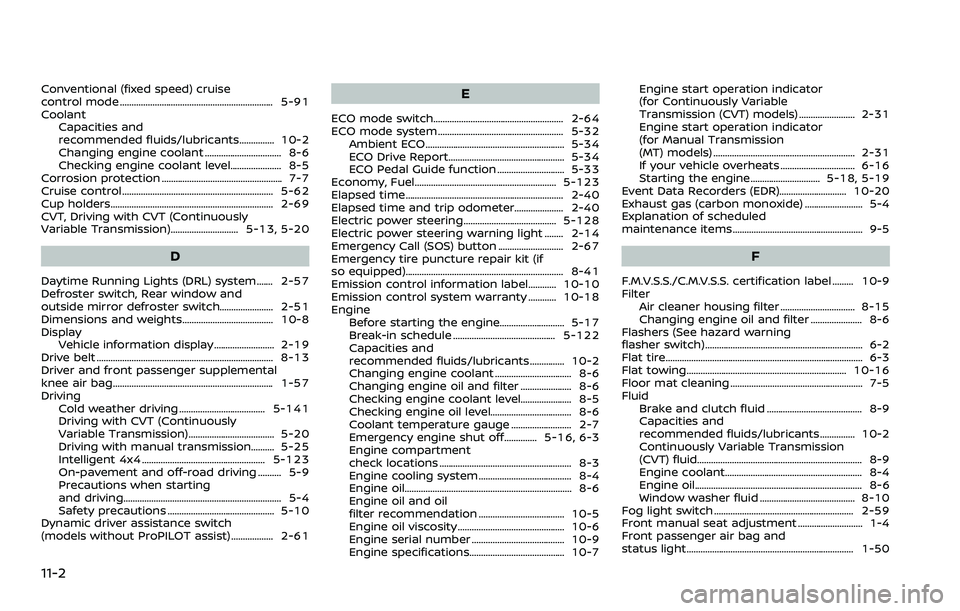
11-2
Conventional (fixed speed) cruise
control mode .................................................................. 5-91
CoolantCapacities and
recommended fluids/lubricants............... 10-2
Changing engine coolant ................................. 8-6
Checking engine coolant level...................... 8-5
Corrosion protection .................................................... 7-7
Cruise control ................................................................. 5-62
Cup holders...................................................................... 2-69
CVT, Driving with CVT (Continuously
Variable Transmission)............................. 5-13, 5-20
D
Daytime Running Lights (DRL) system....... 2-57
Defroster switch, Rear window and
outside mirror defroster switch....................... 2-51
Dimensions and weights....................................... 10-8
Display Vehicle information display.......................... 2-19
Drive belt ........................................................................\
.... 8-13
Driver and front passenger supplemental
knee air bag..................................................................... 1-57
Driving Cold weather driving ..................................... 5-141
Driving with CVT (Continuously
Variable Transmission)..................................... 5-20
Driving with manual transmission.......... 5-25
Intelligent 4x4 ..................................................... 5-123
On-pavement and off-road driving .......... 5-9
Precautions when starting
and driving.................................................................... 5-4
Safety precautions .............................................. 5-10
Dynamic driver assistance switch
(models without ProPILOT assist) .................. 2-61
E
ECO mode switch........................................................ 2-64
ECO mode system ...................................................... 5-32 Ambient ECO............................................................ 5-34
ECO Drive Report.................................................. 5-34
ECO Pedal Guide function ............................. 5-33
Economy, Fuel............................................................. 5-123
Elapsed time.................................................................... 2-40
Elapsed time and trip odometer..................... 2-40
Electric power steering........................................ 5-128
Electric power steering warning light ........ 2-14
Emergency Call (SOS) button ............................ 2-67
Emergency tire puncture repair kit (if
so equipped).................................................................... 8-41
Emission control information label............ 10-10
Emission control system warranty ............ 10-18
Engine Before starting the engine............................ 5-17
Break-in schedule ............................................ 5-122
Capacities and
recommended fluids/lubricants............... 10-2
Changing engine coolant ................................. 8-6
Changing engine oil and filter ...................... 8-6
Checking engine coolant level...................... 8-5
Checking engine oil level................................... 8-6
Coolant temperature gauge .......................... 2-7
Emergency engine shut off.............. 5-16, 6-3
Engine compartment
check locations ......................................................... 8-3
Engine cooling system ........................................ 8-4
Engine oil.....................................................................\
... 8-6
Engine oil and oil
filter recommendation ..................................... 10-5
Engine oil viscosity .............................................. 10-6
Engine serial number ........................................ 10-9
Engine specifications......................................... 10-7 Engine start operation indicator
(for Continuously Variable
Transmission (CVT) models) ........................ 2-31
Engine start operation indicator
(for Manual Transmission
(MT) models) ............................................................. 2-31
If your vehicle overheats ................................ 6-16
Starting the engine.............................. 5-18, 5-19
Event Data Recorders (EDR)............................. 10-20
Exhaust gas (carbon monoxide) ......................... 5-4
Explanation of scheduled
maintenance items ........................................................ 9-5
F
F.M.V.S.S./C.M.V.S.S. certification label ......... 10-9
Filter Air cleaner housing filter ................................ 8-15
Changing engine oil and filter ...................... 8-6
Flashers (See hazard warning
flasher switch).................................................................... 6-2
Flat tire........................................................................\
............. 6-3
Flat towing..................................................................... 10-16
Floor mat cleaning ......................................................... 7-5
Fluid Brake and clutch fluid ......................................... 8-9
Capacities and
recommended fluids/lubricants............... 10-2
Continuously Variable Transmission
(CVT) fluid....................................................................... 8-9
Engine coolant........................................................... 8-4
Engine oil.....................................................................\
... 8-6
Window washer fluid ......................................... 8-10
Fog light switch ............................................................ 2-59
Front manual seat adjustment ............................ 1-4
Front passenger air bag and
status light........................................................................\
1-50